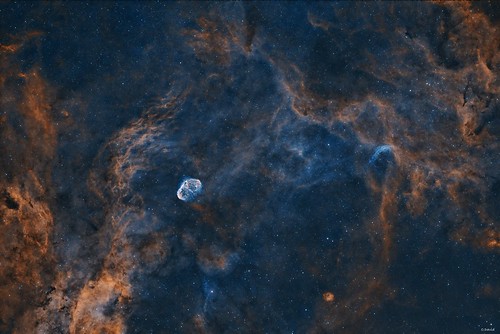This 90 megapixel image is the result of a cooperation with 3 fellow astrophotographers, Sara Wager, Dominique Dierick and Kees Scherer and myself. It all started in 2017 when we worked together on a larger mosaic of part of the Cygnus constellation.
The zoomable result of this cooperation can be seen here:
https://zoomhub.net/al3me
I would recommend to strawl through the image to find all the details. For example the Soap Bubble Nebula, the Cygnus X1 shockwave, Crescent and Tulip Nebula are nicely visible.
Last year (2021) I wanted to make a nice image of the Tulip Nebula (SH2-101) and the nearby hydrogen clouds so I made an image stack consisting of 1 panel of this region. This summer (2022) they predicted a longer period of clear skies and I decided to extend the field of view to get more coverage of this very interesting region.
After finishing this image I noticed that I was very nearby the Crescent nebula region and knew I had a lot of data of that region also, so I decided to look onto my image archive to see which data there was more region and that was how I stumbled onto the mosaic data again that we all captured in 2017. It showed that with this data a very nice field of view could be generated with full coverage from the Tulip up to far above the Crescent nebula. Because of the high quality of the data processing was very easy and that is what resulted in an 90 megapixel image of 4,5x6,2 degrees of sky area.
On my webpage you can find a lot more info and details about the image:
https://www.astro-photo.nl/deepsky/nebu ... o-crescent
Exposures:
Dominique Dierick: 36x300s Crescent (3h)
Sara Wager: 50x1800s Crescent (25h)
Kees Scherer: 38x900s Overall field (9,5h)
André van der Hoeven: 211x900s Detailed regions (52,75h)
Total: 90,25h
Equipment:
Dominique: Takahashi FSQ106/QHY163M
Sara: Orion Optics ODK10/TMB152/QSI683wsg
Kees: Skywatcher Esprit 100D/QHY16200
André: TMB92/QSI583ws
https://www.astrobin.com/full/odqsqz/0/ Mosaique NGC7000 IC5067 IC5068 by Mathieu Guinot, sur Flickr
Mosaique NGC7000 IC5067 IC5068 by Mathieu Guinot, sur Flickr









